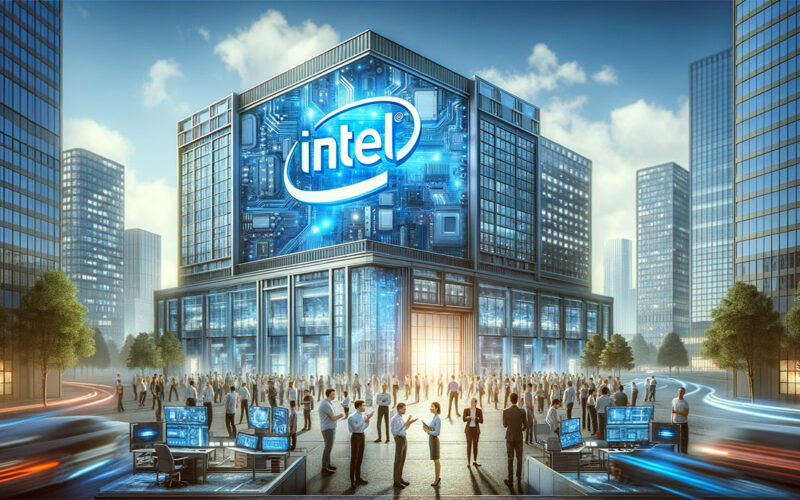Ever marvel at the symphony of technology orchestrating our digital lives? That’s Intel at play, humming beneath the surface of our sleek gadgets and gizmos.
Imagine peering through the silicon curtain to uncover the Intel statistics that signal where tech is trekking next.
You’re here because numbers narrate a tale far beyond mere digits.
They’re the pulse of innovation, the barometer of industry heft.
Through the looking glass of data, from CPU benchmarks to chipset market share, we decode an empire’s ebb and flow.
By the close of this read, expect revelation—how Intel’s heart beats in tandem with our tech thirst. We’ll dissect vast volumes, from silicon Valley tech trends to financial feats like quarterly earnings reports.
Buckle up for an excursion into Intel’s numerical narrative, unearthing global chip sales analysis and data center hardware stats that frame tomorrow’s tech tableau.
Dive into the digits that define a titan of tech.
Intel Statistics To Check Out
- Intel has more than 121,000 employees.
- Intel creates world-changing technology that improves the life of every person on the planet.
- Intel has had a profound influence on the world, driving business and society forward by creating radical innovation that revolutionizes the way we live.
- Intel is committed to helping every one of its employees learn, grow, and thrive.
Financial Insights:
- Intel’s revenue in 2022 is $63 billion.
- Intel’s non-GAAP gross margin is 52%.
- Intel’s non-GAAP EPS is $3.50.
- Intel’s demand for products is highly variable and can differ from expectations due to factors including changes in business and economic conditions.
- Intel’s results can vary significantly based on capacity utilization, variations in inventory valuation, changes in revenue levels, segment product mix, timing and execution of the manufacturing ramp and associated costs, excess or obsolete inventory, and changes in unit costs.
Quarterly and Yearly Reports:
- Intel’s fourth-quarter revenue in 2022 was $14.0 billion.
- Intel’s fourth-quarter revenue in 2022 was down 32 percent year-over-year (YoY).
- Intel’s fourth-quarter revenue in 2022 was down 28 percent YoY on a non-GAAP basis.
- Intel’s full-year revenue in 2022 was $63.1 billion.
- Intel’s full-year revenue in 2022 was down 20 percent YoY.
- Intel’s full-year revenue in 2022 was down 16 percent YoY on a non-GAAP basis.
- Intel’s fourth-quarter earnings (loss) per share (EPS) was $(0.16).
- Intel’s non-GAAP EPS was $0.10 in the fourth quarter of 2022.
- Intel’s full-year EPS was $1.94.
- Intel’s non-GAAP EPS was $1.84 in full-year 2022.
- Intel is forecasting first-quarter 2023 revenue of $10.5 billion to $11.5 billion.
- Intel is expecting first-quarter EPS of $(0.80).
- Intel is expecting first-quarter non-GAAP EPS of $(0.15).
- Intel’s board of directors has declared a quarterly dividend of $0.365 per share on the company’s common stock.
- Intel’s quarterly dividend will be payable on March 1, 2023.
- Intel’s quarterly dividend will be payable to shareholders of record as of February 7, 2023.
Economic Impact:
- Intel’s impact on the US economy is estimated in a report.
- Intel’s impact on the US economy is estimated in four of its key states: Arizona, California, New Mexico, and Oregon.
Products and Features:
- Intel’s product portfolio provides end-to-end solutions that address the needs of an ever-evolving data-centric world.
- Intel’s products include processors, chipsets, FPGAs, SSDs, and memory.
- Intel’s processors are used in a variety of devices, such as desktops, laptops, servers, PCs, and IoT devices, and are designed to be energy-efficient, high-performance, scalable, and secure.
- Intel’s chipsets support processors and are utilized in PCs and servers. They’re designed to be energy-efficient, high-performance, scalable, and secure.
- Intel’s FPGAs are programmable devices for applications in data centers, networking, and automotive. They’re designed to be energy-efficient, high-performance, scalable, and secure.
- Intel’s SSDs are used for data storage across various devices, including PCs, servers, and data centers. They’re designed to be energy-efficient, high-performance, scalable, and secure.
- Intel’s memory is used in PCs, servers, and data centers. It’s designed to be energy-efficient, high-performance, scalable, and secure.
- Intel products are designed to be compatible with various operating systems, software applications, hardware devices, networking protocols, cloud platforms, virtualization technologies, and AI frameworks.
FAQ On Intel Statistics
What is Intel’s current market share in the semiconductor industry?
Intel, a titan of tech, still grips a substantial slice of the semiconductor sphere. Recent shifts show they’re jostling among global giants while anchoring a dominant position in areas like microprocessors where their silicon shines.
How has Intel’s revenue grown over the past year?
Talk about an upswing—Intel’s fiscal fitness flexed with revenue sprouting in key segments, nodding to a robust appetite for their chipsets, despite ‘chip-tanic’ supply snags. Their financial framework tells a tale of resilience and rigorous reinvestment in areas like AI and autonomous tech.
What are the performance metrics for Intel’s latest processors?
Intel’s latest CPU darlings impress with boosts in speed and efficiency, thanks to their tick-tock technological tango. Ranging from everyday efficiency to beastly benchmarks, these chips are measured not just in GHz but in real-world wrangling—from gaming glory to creative crunching.
What is Intel’s average selling price (ASP) for CPUs?
Their ASP? A dance between demand and die size. Intel plays it smart, tweaking tags to reflect the intricate interplay of performance perks versus production costs. Expect premiums for bleeding-edge brilliance and savvy savings on staple silicon.
How does Intel’s R&D expenditure compare to its competitors?
In the ring of R&D rumble, Intel is no slouch, funneling fabulous funds into future-facing fields. It’s a high-stakes hustle, with Intel betting big bucks on tomorrow’s tech to stay a step ahead of silicon scuffle with the likes of AMD and NVIDIA.
What is the growth trend for Intel’s data center hardware?
Data centers—a digital dominion where Intel’s making moves. Growth gurus point to hearty health in their high-powered hardware for hyperscale heavens, nudging network needs to new heights and harvesting heaps of hefty contracts that bode well for the balance sheet.
How does Intel’s integrated graphics performance fare against external GPUs?
Intel’s integrated graphics have leaped lengths lately, but let’s level: standalone GPUs still steal the show in sheer strength. Nevertheless, for the average artist or everyday multitasker, Intel’s offerings offer ample oomph without guzzling gobs of green.
What impact has Intel’s processor sales had on the PC market trends?
Every electron enthusiast knows: processor prowess pushes PC paradigms. Intel’s innovation injects impetus into the market, molding the mold for mainstream manufacturing and compelling competitors to catch the current or be cast away in the tech tempest.
How do Intel’s quarterly earnings reports influence investor confidence?
Quarterly earnings reports? A financial flashback that can either fuel fervor among the fiscal faithful or send shivers down shareholders’ spines. Intel’s ledger leans toward the lucrative, managing more often than not to muster market mojo and maintain monetary morale.
How does Intel compare to AMD in terms of technology and market share?
Ah, the age-old scrimmage of silicon supremacy: Intel and AMD. In techno terms and territory taken, it’s a saga of swings and roundabouts. Intel touts tenacity in the server sector and laptops, AMD’s got game with graphics guts and desktop dominance. The duel dazzles on.
Conclusion
So, we’ve dove deep, surfacing with hands full of Intel statistics that sketch the silicon giant’s footprints across our digital landscape.
- From processor sales figures that map out a blueprint of market maneuvers,
- To the semiconductor industry data that whispers of waves Intel’s riding into tomorrow.
It’s clear, this journey through datasets and digits paints a picture vibrant and vital. We’ve charted their climb, etching tales of triumphs into the ledger of tech lore, and, yeah, noted the occasional stumble. Our exploration, rich with CPU benchmarks and revenue growth, distilled the essence of an industry innovator, leaving us brimming with insights.
As curtains close on our numerical narrative, we look ahead, knowing the data deciphered today is merely the prologue of Intel’s unfolding saga—a tale of technology tirelessly toiling towards a tomorrow teeming with teraflops and tech transcendence.
If you liked this article about Intel statistics, you should check out this article about Adobe statistics.
There are also similar articles discussing Alibaba statistics, Amazon statistics, AMD statistics, and Apple statistics.
And let’s not forget about articles on Cisco statistics, Facebook statistics, IBM statistics, and Microsoft statistics.
- Creative Collages: Designing with Apps Like PicCollage - April 27, 2024
- TypeScript Today: What is TypeScript Used For? - April 27, 2024
- Professional Video: Cinematography Apps Like FiLMiC Pro - April 26, 2024









